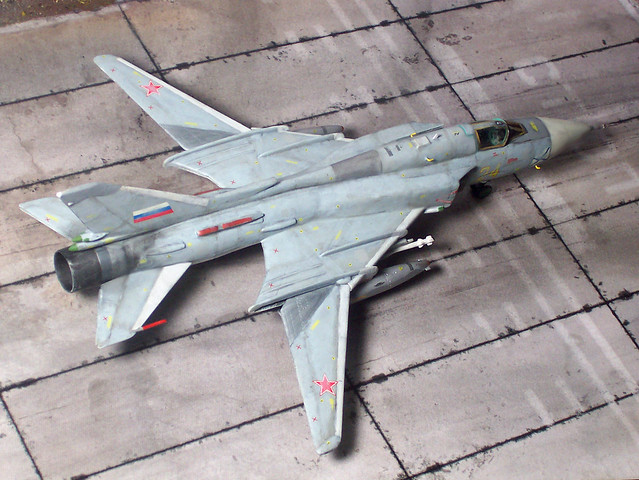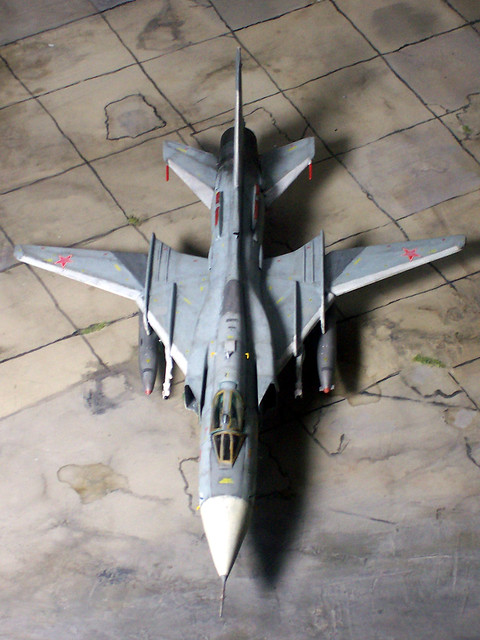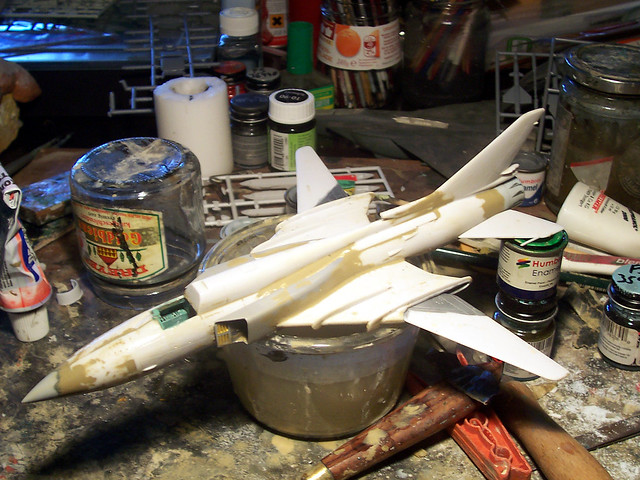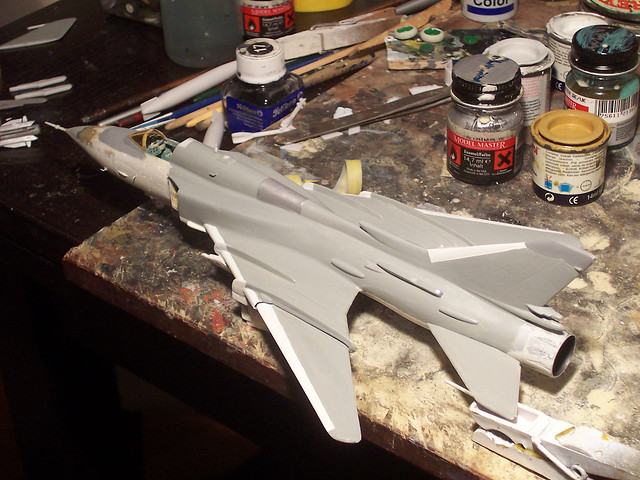Brandneu, gerade am Wochenende fertig geworden - das fehlende Glied in der Suchoj-Familie, die Su-18 (NATO Code 'Fitter N'):
Some background:The Su-18 was the final evolutionary step in the long journey of the Su-7 fighter bomber. Seeking to improve low-speed and take-off/landing performance of the Su-7B fighter-bomber, in 1963 the Sukhoi OKB with input from TsAGI created a variable-sweep wing technology demonstrator.
The Su-7IG (internal designation S-22I, NATO designation "Fitter-B"), converted from a production Su-7BM, had fixed inner portions of the wing with movable outer segments which could be swept to 28°, 45°, or 62°. A fixed inner wing simplified construction, allowing the manufacturer to retain the Su-7 landing gear and avoiding the need for complex pivoting underwing hardpoints, and it minimized the shift in the center of pressure relative to the center of mass with change in wing sweep. The new wing also had extensive leading-edge slats and trailing-edge flaps. Su-7IG first flew on 2 August 1966 with V. S. Ilyushin at the controls, becoming the first Soviet variable geometry aircraft. Testing revealed that take-off and landing speeds had decreased by 50–60 km/h (31–37 mph) compared to the conventional Su-7.

The production aircraft was named Su-17 (NATO designation "Fitter-C", factory designation S-32) and was unofficially dubbed Strizh (Стриж, martlet) in service. Aside from the new wing, it differed from its predecessor Su-7 in having a new canopy and a dorsal fuselage spine for additional fuel and avionics. The Su-17 first flew on 1 July 1969.
The Su-17 saw several development steps, ending with the capable Su-17/22M3 and Su-17/22M4; the latter made its maiden flight in 1980 and the last variants were produced until 1990.


The Su-22M4 was also operated by the Soviet Naval Aviation (Авиация военно-морского флота in Russian, or Aviatsiya Voenno-Morskogo Flota, literally "aviation of the military maritime fleet") in the attack role, and from the beginning it was clear that the type had no sufficient capability for tactical strikes, esp. against sea targets. The Su-24 tactical bomber was an option, but it was complex and expensive, so that an upgrade of the Su-17 was considered. Primary requirement was a more capable radar/attack suite, tailored to a naval environment, and a better/more modern engine, esp. with a better fuel efficiency.

OKB Sukhoi started to take on the task in 1982. Effectively the design team tried to create a "Su-24 light" on the basis of as many proven Su-17/22 elements as possible. The project received the internal designation S-54D. Mission avionics were to comprise the ‘котёнок‘ (= ‘Kitten’) suite, a slimmed-down 'Puma' nav/attack system optimized for naval environment. This system complex consisted of two Orion-A superimposed radar scanners for nav/attack, a dedicated Relyef terrain clearance radar to provide automatic control of flights at low and extremely low altitudes, and an Orbita-10-58 onboard computer.
It soon became clear that the original Su-17/22 airframe with nose air intake and its central shock cone did not offer sufficient space for the radar scanners, so OKB Sukhoi had to modify the complete nose section in order to fit a large radome. This radically modified aircraft was designated T-54DM and presented as a mock-up in 1984.


To create sufficient room, the box-shaped air intakes were moved to the flanks and into the wing roots, what meant that the original NR-30 cannons were omitted. As a positive side effect, top speed at height and supersonic performance were reinstated since the Su-17M4's fixed nose cone was replaced by effective, adjustable splitter plates (not unlike the design on the Su-15 interceptor) in the new air intakes - getting the new aircraft's top speed back to more than 2.000 km/h at height. On the other side, the space for the original air duct around the cockpit could be used for avionics and other mission equipment, including a pair of more modern GSh-30-1 30 mm cannons in the lower front fuselage with a 150-round magazine each, which were more effective against groud and air targets alike.
Concerning the engine, the Su-17's Lyulka AL-21F-3 afterburning turbojet was to be replaced by the new and promising Soyuz R-79F-100 turbofan that yielded about 15% more thrust than the original AL-21F, even though fuel consumption was not much better and reliability remained a serious problem throughout the Su-18's career, how the type was officially called in service when it was delivered in early 1987 to the Baltic and Black Sea fleet.
When the aircraft was discovered on NATO’s satellite pictures, it was erroneously interpreted as a Su-22 export version for China (since the new nose arrangement reminded a lot of the Q-5 modification of the MiG-19 fighter), and some ‘experts’ even considered the Su-18 to be an interceptor version of the swing-wing fighter bomber. Anyway, since the Su-18 was still seen as part of the huge Su-7 family it kept its ‘Fitter’ ASCC code, with the ‘N’ suffix.
The Su-18’s service was short and ambivalent, though. The type was only introduced to the Soviet Naval Aviation, since its котёнок avionics suite was rather limited in scope and could not match up with the Su-24’s ‘Puma’ system. Additionally, the Su-27 multi-role fighter had become a more versatile option for the Soviet Air Force, which had begun to face a severe re-structuring program.
Positive asset was the fact that the Su-18 did not require much flight training – no trainer version was ever built and training was done on Su-17M3 two-seaters. On the other side the single crew layout coupled with the complex weapon system made flying and weapon operations at the same time rather demanding, so that the Su-18 could hardly play out its full potential.
Only about 120 Su-18s were produced until 1990, and in a move to eliminate single engine strike aircraft from its inventory the Russian Air Force already retired its last Su-17M4 along with its fleet of MiG-23/27s in 1998, while the Su-18 in Naval Aviation service soldiered on until 2000. Some countries like Peru and Indonesia showed interest in these aircraft, but all were destroyed in the course of the bilateral START (Strategic Arms Reduction Treaty) treaty.
General characteristics: Crew: 1
Length (incl. pitot): 19.44 m (63 ft 8 in)
Wingspan:
Spread: 13.68 m (44 ft 11 in)
Swept: 10.02 m (32 ft 10 in)
Height: 5.12 m (16 ft 10 in)
Wing area: 38.5 m² (415 ft²) spread, 34.5 m² (370 ft²) swept
Empty weight: 12,160 kg(12.2t) (26,810 lb)
Loaded weight: 16,400 kg(16.5t) (36,155 lb)
Fuel capacity: 3,770 kg (8,310 lb)
Powerplant: 1× Soyuz R-79F-100 turbofan, rated at 99 kN (22.275 lbf) dry thrust and 130 kN (29.250 lbf) with afterburner
Performance: Maximum speed:
1.400 km/h (755 knots, 870 mph) at sea level
2.150 km/h (1.159 knots, 1.335 mph, Mach 1.9) at altitude
Range:
1,150 km (620 nmi, 715 mi) combat range in hi-lo-hi attack with 2.000 kg (4.409 lb) warload; ferry range: 2.300 km (1.240 nmi, 1.430 mi)
Service ceiling: 14,200 m (46,590 ft)
Rate of climb: 230 m/s (45,275 ft/min)
Wing loading: 443 kg/m² (90.77 lb/ft²
Thrust/weight: 0.68
G-force limit: 7
Airframe lifespan: 2,000 flying hours, 20 years
Armament: 2 × 30 mm GSh-30-1 cannons with 150 RPG in the lower front fuselage
Up to 4000 kg (8,820 lb) on ten hardpoints (three under the fixed portion of each wing, four on the fuselage sides), including Kh-23 (AS-7 'Kerry'), Kh-25 (AS-10 'Karen'), Kh-29 (AS-14 'Kedge'), Kh-31A & P (AS-17 ‘Krypton) anti-shipping/anti-radiation missiles and Kh-58 (AS-11 'Kilter') guided missiles, as well as electro-optical and laser-guided bombs, free-fall bombs, rocket pods, cluster bombs, SPPU-22-01 cannon pods with traversable barrels, ECM pods, napalm tanks, and nuclear weapons.





Dieser Jagdbomber ist aus einer Diskussion auf whatifmodelers.com bzgl. einer verbesserten Su-17/22 entstanden, und ich konnte mich an eine photogeshoppte "Version" in USAF-Markierungen erinnern:

Warum nicht so etwas bauen - aber möglichst ohne konzeptionelle Fehler wie Unterschall-Lufteinläufe (einer A-4) oder die Kanonen direkt davor.
Größten Bammel, den ich hatte, waren die Lufeinläufe - die müssen ja irgendwo hin und in den Rumpf integriert werden. Ging aber rel. gut!
Die Basis ist eine Su-17M4 von Smer, ein leidlicher Bausatz der zwar gut detailliert ist, aber wo kaum etwas zusammenpasst. Verändert wurde:
- Lufteinläufe & Splitter-Platten einer Su-15 von PM Model
- Die Kanäle dahinter sind halbierte Kühlerwannen von einem Tragflächenkühler einer Art Model Bv 155
- Das Radom stammt von einer F-15
- Das Bugrad ist neu, incl. Räder einer MiG-29, und es fährt nun nach hinten ein, um die Proportionen der dicken Nase zu kompensieren

Beim Anstrich wollte ich etwas Authentisches, aber es sollte ungewöhnlich sein - und es sollte eine Maschine der russ. Marinestreitkräfte werden. Die Lackierung ist 1:1 von taktischen Bombern wie der Su-24 übernommen - wurde nie auf einer Su-17 verwendet (der Typ wurde von der Marine geflogen, aber nur in taktischen grün-braunen Tarnungen), steht ihr aber bombe.

Die Kh-31A-Flugkörper stammen aus dem ICM-Waffensatz, Tanks und R-60 AAMs vom Smer-Bausatz.
Insgesamt bin ich erstaunt, wie stimmig das Ding letztlich geworden ist, mit rel. wenig Umbauten.